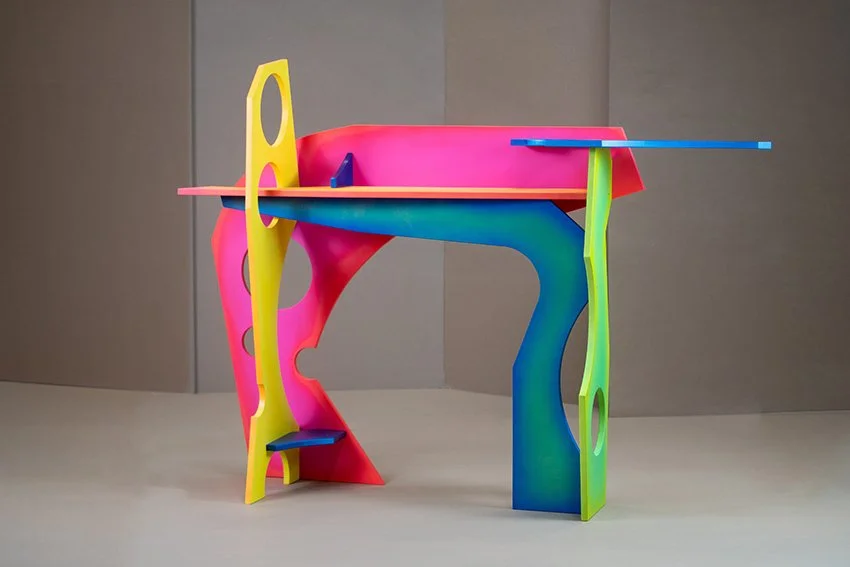Interview with Kiki and Joost
Living in a broadly individualistic society that is fraught with divisive messaging, exasperated by a collective reliance on social media platforms, can often make the world feel like a disconnected and even lonely place to be. Perhaps more than ever, collaboration seems like a pertinent antidote to the situation, which is something Dutch designers Kiki van Eijk and Joost van Bleiswijk know from first hand experience.
The pair met and graduated from the Design Academy Eindhoven at the turn of the Millenium and have since continued to develop their own unique individual practices while organically growing their shared Kiki & Joost brand as studio and life partners. During this years Dutch Design Week they launched their new exhibition space with Carte Blanche, a riotous display of their combined output in the form of brightly coloured textiles, abstract forms and sculptural delights. The vibrancy of the space and all the work on show left a memorable mark, and I couldn’t wait to find out more about how the sensational partnership came about and has evolved to allow space for each of their distinctive styles to flourish.
JB: I’m always interested by partnerships - how they have come together and work – and am aware that you’ve both come have your own individual practices. Can you tell me little about how and why you have merged as a brand?
K&J: Most of the time, we work on separate projects but stay deeply involved in each other's processes through feedback and brainstorming. Sometimes, these collaborations lead to joint projects, for example in interior architecture commissions, but more often, it’s about showcasing our individual voices side by side. Our team plays a significant role too - skilled craftspeople and collaborators are essential to us. They’re not just there to meet deadlines and production schedules; they’ve become an integral part of our studio. Many of them have been with us for years, and while it may sound like a cliché, they really are part of our family. We mean that, including the younger students that pass by for internships.
When it comes to our specific collaboration, the story is more nuanced. We studied together, started our first studio together after the academy, are partners in life, have children together, and live and work side by side. There’s a lot to be said about bringing together people with different mindsets and visions. If you can create space for freedom and mutual respect, it can only strengthen the practice.
JB: Is there ever any risk of your ideas bleeding into one anothers - does it ever feel tricky to retain your individual design identities?
K&J: We each have different approaches to our work and probably very different aesthetics, but together we are stronger. We rely on each other's perspectives in the creative process, and that dynamic makes what we do richer and more vibrant. It’s important for us both to keep our own identities and qualities, that’s why we mostly work separately for different clients. We have our own companies, but since we work and often exhibit side by side in the same building people started to recognize our names as Kiki & Joost, and that just grew naturally. The truth is, we didn’t strategically decide it, nor did we consciously build a brand. We are two individual creatives working and living together.
JB: I guess it all began when you were studying together at Design Academy Eindhoven, but can you tell me how things grew into the amazing studio you have today?
K&J: There was a big crisis in the world and NL when we graduated, so practically no work at design studio’s! We decided to stay in Eindhoven and start our own studio. There were not many design studio’s and ateliers back in the days in Eindhoven. We used anti-squat places as ateliers, and even squatted a place, and then changed 8 times between rented spaces before we decided to buy and built our own studio in 2020. We started investing in tools each time we had a commissioned project. First an electronic screwdriver, then some drills, sanding machines, a small circular table saw, until we grew into a fully equipped workshop with metal, wood, ceramic and textile works, tools, machines like we currently have. We have always been working on experimental autonomous works alongside commissioned projects for freedom of expression and artistic growth. But also to give the world a broad spectrum of examples of what we are capable of. We have a strong and small core team: Kiki, Joost, David Bruijgom, Annemiek van der Beek & Ruben Smulders. Next to that we work with interns and freelance people. We go max. up to 12 people, that’s our lunch table policy : that’s the max. amount of people that fit around our lunch table and we don’t want to grow bigger. We want to keep the team dynamic, creative, clear and manageable.
Kiki
JB: I’m always interested in how designers apply materials and colour, and you each have bold and playful ways of combining them. Can you share some insight into how you approach them?
Kiki: Colour is my way of storytelling. I let my intuition guide me, often beginning with one small element that sparks an idea, and then I build from there. I love exploring how details - like the specific shade of a fabric or the texture of a surface or a weed or a flower, my son drawing - can create a sense of wonder and spark research that ends up in forms and shapes. I believe my work is an invitation for people to see things through a different lens.
Kiki
The intuitive side of our practice is very cherished. Of course, it doesn’t mean that we don’t edit or research or that we produce everything that comes to mind, but it means that we try to be focused and real about who we are. I cherish that creative sparkle, my creative identity. Colour is an important part of my identity and expression. I’m always very particular in choosing colours, it’s my second nature. I can mix any color I have in my mind on paper with paint. And I can mix any colour in my mind. I play with colour contrasts in each work I do. It gives shape to the identity of the finished pieces and goes hand in hand with the choice of material and form.
Joost
Joost: My approach to materials is raw and instinctive, almost like a dialogue with the material itself. I’m drawn to unconventional combinations - like pairing industrial elements with bold colors - to push boundaries of materials and shapes. The "punk aesthetic" comes from this desire to experiment and challenge norms while still aiming for something refined. It’s a very physical and expressive way of working, and often tiring, but it is the part I love the most. I crave the process, the physicality of it, the building, the idea taking shape, the difficulties, and the solutions you need to find. When the job is done and the piece is in the space for fruition I almost lose interest. I am there for the energy of the making, the rest is up to to client or the public.
JB: You launched your new self-designed exhibition space spectacularly during Dutch Design Week and it’s a stunning space – both in terms of the work on display and the building itself. How did you go about the process, did I read that it only took a matter of days?
K&J:Building the space was intense and fast-paced. We’re not talking days - more like 9 months - but still pretty fast for such a project. However, the main Douglas Fir structure - which was prefab, CNC-routed, without glue or screws - was constructed in only 2 days! It was exhilarating. Like with building our workshop and studio space, we wanted to use the same sustainable materials. The great thing about Eindhoven is that it’s a real working city with a strong cultural community. Many creatives that are part of the scene have almost an anarchic approach to life: you can shape your own life and you are responsible for that yourself. Many of us are very entrepreneurial and experimental. The combination of these aspects creates the need for big spaces to be free for experimenting. That’s how we decided to build our own space - independently without leaning on anyone else’s shoulder. We wanted the exhibition to feel immediate and alive, almost like stepping into the heartbeat of our work.
Joost
JB: It really did feel that way - super vibrant and pulsating. As ever, it made me rather envious of the type of workshop you see throughout the city during Dutch Design Week!
K&J: Our overall setup is a reflection of Eindhoven’s creative ecosystem. We have a workshop that’s both a laboratory and a playground, filled with tools and materials that allow for experimentation. The new exhibition space is an extension of that energy - a place to showcase finished pieces but also to host events, share ideas, and collaborate. It’s about creating a dialogue, not just a display. It’s a great privilege to have the possibility to have a space to experiment, outside of commercial logic and pressure. The courtyard garden, which connects the workshop and exhibition space, is a little world on its own. It’s peaceful, restful and a great place to hang out with visitors, or on your own. In the studio breaks we play petanque on our special lane that we made for it. In spring and summer flowers start to bloom and the Jasmins have a wonderful smell. All year round we have great plants and different grasses, which makes it always pleasant to be there. Please come to see us again, we’d love to have you and everyone reading this article to experience that. We have already had so many meaningful encounters here since we opened the space last June.
JB: Eindhoven really does continue to impress me year-on-year with the sheer volume and quality of design happening throughout the city and it strikes me that the Design Academy plays a big role in this. It’s shaped your personal journeys, and I noticed that you are offering the space to DAE students next year. Can you tell me about your experiences of the school?
K&J: The Design Academy is where we both found our voices as designers. It’s more than a school - it’s a culture of questioning, experimenting, and learning how to think critically about design. And one of Anarchy! That mindset has shaped who we are and how we approach our work. You can see Design Academy as a lifelong family. It’s a very special connection and community we have amongst each other. For 4 years we have been leading a design department at the school that we set up ourselves. It’s called “Thinking Hands”. It’s about finding the right balance between thinking and making and following your intuition. Following the path of process that your hands offer you while making. We try to inspire students with our own insights, vision, experience and it’s great to give something back to the DAE community in this way.
Opening our space to some DAE students in the future is our way of giving back to that community. We want to create opportunities for them to explore, experiment, and share their ideas in a real-world context. Eindhoven thrives because of its openness to new perspectives, and we’re excited to be part of that ongoing conversation. On top of that DAE will move in 3-4 years to a new building in the very same street as ours, which will be also a great injection for the design district that the city plans to develop there.
This article was first published by Design Insider.








